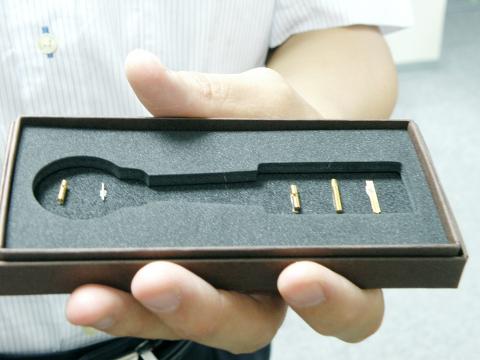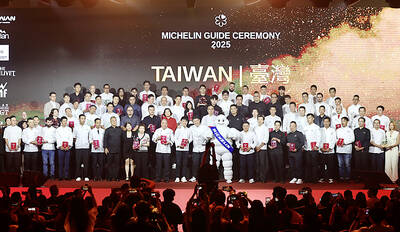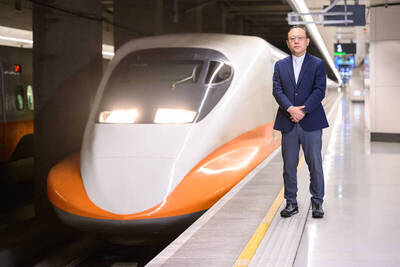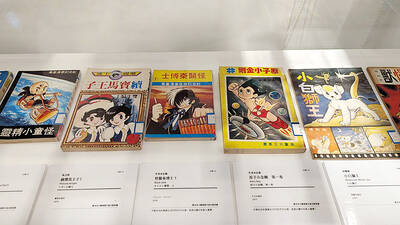A research team from National Taiwan Normal University (NTNU) yesterday unveiled a quantitative detection technique that can instantly determine the density of various substances in the air by analyzing the changes in frequency when air is blown through a tiny whistle.
Lin Cheng-huang (林震煌), a professor at the university’s department of chemistry, said that with the new detection method invented by his research team, rapid screening for diabetes by measuring acetone levels in breath could become possible in the near future.
The research project, funded by the National Science Council, is the first in the world to use the analysis of sound frequency to determine gas composition and its density, Lin said, adding that the new technique obviates the need for a calibration curve to determine the quantity of substances, as is used in the most common techniques currently available.

Photo: Tang Chia-ling, Taipei Times
Compared with current common techniques for gas detection through chemical principles, the new technique’s detection -principle comes from physics — by applying a specially designed whistle after the process of gas chromatography (separation of the different components in the gas) and analyzing the various sound frequencies created as the substances are blown through the whistle, Lin said.
Lin said the team was cooperating with other research teams, especially on the development of a household medical device to detect acetone levels in a person’s breath — which is likely to be a fast screening method for diabetic ketoacidosis.
Most people dislike intrusive methods such as blood tests, so if the device proved effective in further experiments, it could potentially reduce the need for such tests, Lin said.
By blowing air into the device and waiting for a few minutes for the analysis, users can easily detect acetone levels in their breath, he said.
Lin added that the team hopes to make the device easy to operate and available in the handy size of an iPad, so that it can be used for daily health monitoring.

Eight restaurants in Taiwan yesterday secured a one-star rating from the Michelin Guide Taiwan for the first time, while three one-star restaurants from last year’s edition were promoted to two stars. Forty-three restaurants were awarded one star this year, including 34 in Taipei, five in Taichung and four in Kaohsiung. Hosu (好嶼), Chuan Ya (川雅), Sushi Kajin (鮨嘉仁), aMaze (心宴), La Vie by Thomas Buhner, Yuan Yi (元一) and Frassi in Taipei and Front House (方蒔) in Kaohsiung received a one-star rating for the first time. Hosu is known for innovative Taiwanese dishes, while Chuan Ya serves Sichuan cuisine and aMaze specializes

Taitung County is to launch charter flights to Malaysia at the end of this year, after setting up flights to Vietnam and Thailand, the Taitung County Government said yesterday. The new charter flight services, provided by low-cost carrier Batik Air Malaysia, would be part of five-day tour packages for visits to Taitung County or Malaysia. The Batik Air charter flight, with about 200 seats, would take Malaysian tourists to Taitung on Dec. 30 and then at 12:35pm return to Kuala Lumpur with Taiwanese tourists. Another charter flight would bring the Taiwanese home on Jan. 3 next year, arriving at 5:30pm, before taking the

Taiwan High Speed Rail Corp. (THSRC) plans to ease strained capacity during peak hours by introducing new fare rules restricting passengers traveling without reserved seats in 2026, company Chairman Shih Che (史哲) said Wednesday. THSRC needs to tackle its capacity issue because there have been several occasions where passengers holding tickets with reserved seats did not make it onto their train in stations packed with individuals traveling without a reserved seat, Shih told reporters in a joint interview in Taipei. Non-reserved seats allow travelers maximum flexibility, but it has led to issues relating to quality of service and safety concerns, especially during

An exhibition celebrating Taiwan and Japan’s comic culture opened on Saturday in Taichung, featuring a section that explores Taiwanese reproductions of Japanese comics from when martial law limited Japanese representation. “A Century of Manga Culture: An Encounter of Taiwan and Japan’s Youth” held its Taiwan opening ceremony at Taichung’s National Taiwan Museum of Comics after an initial one-month run in Japan’s Kyoto International Manga Museum between May 24 and June 24. Much like the Kyoto exhibition, the show mainly celebrates the comic connection between Taiwan and Japan through late Taiwanese comic book